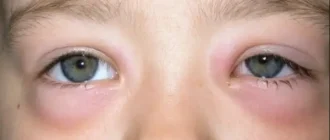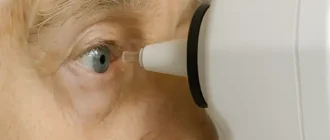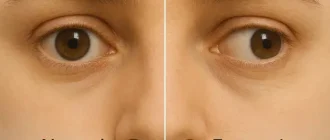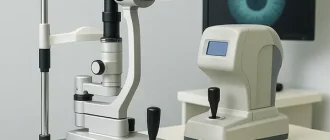Myopia, commonly known as short-sightedness, is a visual condition where close objects appear clear, while distant objects seem blurry. Roughly 41.6% of Americans are myopic today—yes, nearly half the population is squinting at street signs!
Myopia Prevalence by Age Group
A clear snapshot of how myopia rates climb from childhood into adolescence, peaking sharply around age 14, then decreasing slightly in adulthood. The visual demonstrates age-based variations in myopia prevalence, highlighting a critical window in early teen years.
Why Does Myopia Worsen Over Time?
Imagine your eyeball as a camera. In people with myopia, that camera body gets a bit too long. This elongation causes light to focus in front of the retina instead of directly on it, leading to blurry distance vision. The real twist? That camera body can keep stretching.
Most cases of myopia begin in childhood. As children grow, their eyeballs grow too—sometimes a little too enthusiastically. This eye elongation usually continues through adolescence. It’s like kids hitting a growth spurt, but instead of legs getting longer, it’s the eyeball.

The more the eye elongates, the higher the myopia. This can lead to stronger prescriptions, more frequent lens changes, and in high cases, higher risks for serious complications like retinal detachment or glaucoma.
Why does it sometimes keep progressing into adulthood? Factors like extended screen time, high academic pressure, and not enough exposure to daylight can contribute to continued strain and slow elongation of the eye even past the teen years. In rare cases, even adults in their 30s or 40s might notice gradual worsening.
So yes, myopia has a tendency to worsen over time—especially if left unchecked. The good news? With the right interventions, we can slow it down or even stop it in its tracks. ⧉
Regional Urban vs Rural Prevalence
Illustrates urbanization’s role in vision health, with significantly higher myopia prevalence observed among urban youth compared to their rural counterparts. This disparity highlights environmental and lifestyle influences in eye development during formative years.
Who is More Likely to See Their Vision Deteriorate?
While age plays a key role in how myopia develops, several other risk factors can accelerate its progression:
- Genetics: Studies show that if one or both parents are nearsighted, the chances of their children developing myopia significantly increase. It’s not just a coincidence—it’s a documented hereditary link.
- Excessive Screen Time: Spending long hours staring at screens (phones, tablets, laptops) can strain the eyes and contribute to faster progression, especially in younger individuals.
- Limited Outdoor Activities: Children who spend less than 1–2 hours outdoors daily are more likely to experience worsening myopia. Natural daylight plays a protective role in eye development. ⧉
🔍 Key Myopia Risk Factors
⚙️ Genetics
Risk Increase: ≈60%
Children with nearsighted parents have ~60% higher chance of developing miopia.
📱 Screen Time
Risk Increase: ≈35%
Extended digital device use can raise myopia progression risk by ~35%.
💡 Limited Outdoor Time
Risk Increase: ≈50%
Less than 1–2 h spent outdoors daily linked to ~50% higher progression risk.
🎓 Academic Pressure
Risk Increase: ≈25%
Intense near work and study hours may boost progression risk by ~25%.
Diagnosing Myopia: Modern Techniques
Modern diagnostics for myopia are quick, high-tech, and surprisingly comfortable. If you’ve ever worried an eye exam might be unpleasant—relax. Today’s tools are efficient and gentle, like a spa day for your eyeballs.
Autorefractor
Think of this as a “camera for your eyes.” You rest your chin on a stand, stare at a blurry image (usually a farmhouse or a balloon), and in seconds, the machine analyzes how light reflects off your retina to determine your prescription.
- Experience: No drops, no discomfort. Feels like having your photo taken.
- Accuracy: 9/10
- Average Cost: $50–$100
Optical Coherence Tomography (OCT)
OCT scans are like getting an MRI for your eyes—but in under 5 minutes. You’ll sit still while a device scans the inner structures of your eye, creating detailed 3D images.
- Experience: Non-invasive, no touching the eye. You just stare at a target.
- Accuracy: 10/10
- Average Cost: $100–$300
Visual Acuity Test
This is the good ol’ “read the letters on the wall” test. It’s basic but still a crucial part of diagnosing myopia.
- Experience: Familiar, straightforward, takes about 5 minutes.
- Accuracy: 7/10 — great as a screening tool, but often paired with other tests.
- Average Cost: Typically included in standard eye exams ($40–$70)
Modern Treatments to Curb Myopia Progression
Orthokeratology (Ortho-K)
Ortho-K involves wearing specially designed rigid gas-permeable lenses overnight that gently reshape your cornea while you sleep. It’s like giving your eyes a mini workout session while you rest. In the morning, the lenses are removed, and vision remains clear for the day—no glasses or daytime contacts needed.
- How it works: Temporarily flattens the cornea to correct the focal point of incoming light.
- Effectiveness: 8.5/10 (especially in children and teens)
- Cost: $1,000–$2,000 per year (includes lenses and follow-ups)
- Comfort: Moderate. Some initial adjustment required, but users often adapt within a week. ⧉
Atropine Eye Drops
These low-dose medicated eye drops are typically used at bedtime to slow myopia progression in children. It might sound intense, but the dose is so low (usually 0.01%) that side effects are rare and minimal.
- How it works: Relaxes the eye’s focusing mechanism, reducing the signal for eyeball elongation.
- Effectiveness: 9/10 (especially in ages 5–14)
- Cost: $30–$60/month
- Comfort: High. Easy to apply and rarely causes discomfort. ⧉
Multifocal Contact Lenses
These lenses are worn during the day and have multiple zones for different focal distances—think of them as multitasking lenses. While correcting vision, they also send signals to the retina that discourage the eye from elongating.
- How it works: Central zone for distance vision; outer zones defocus peripheral light to slow eye growth.
- Effectiveness: 8/10
- Cost: $600–$1,000 per year
- Comfort: High. Feels like regular soft contacts, easy adaptation for most users. ⧉
Real-Life Myopia Story from the US
Consider this intriguing case: A 28-year-old female software engineer from Seattle found her myopia worsening steadily, from -1.5 diopters at age 20 to -3.75 by age 28. Despite regular use of glasses, she faced difficulties driving at night and reading distant street signs. After starting Ortho-K, her condition stabilized significantly within two years.
Handy Table: Myopia Progression Rate by Age
| Age Range | Typical Progression Rate |
|---|---|
| 6-15 | -0.50 to -1.00 diopters/year |
| 16-25 | -0.25 to -0.50 diopters/year |
| 26-35 | Generally stable, minimal changes |
| 36+ | Rarely progresses, usually stable |
Can You Really Prevent or Slow Myopia Progression?
Absolutely! Taking proactive measures such as spending more time outdoors, limiting screen time, and getting regular eye check-ups significantly reduces the risk. Reyus Mammadli, a medical consultant, strongly recommends parents encourage their children to spend at least two hours outside daily to decrease myopia risks.
Trends in US Myopia Prevalence
Highlights the rise in nearsightedness in American adults over recent decades. The chart clearly visualizes a significant increase in myopia rates, emphasizing the growing public health concern and the need for early interventions.
Editorial Advice
Myopia does tend to worsen with age, particularly during childhood and adolescence. However, modern advancements in eye care provide effective strategies to manage and slow its progression. Regular check-ups and staying informed about the latest treatments can keep you seeing clearly into the future. Remember, prevention truly is worth a pound of cure—so give your eyes the break they deserve!





